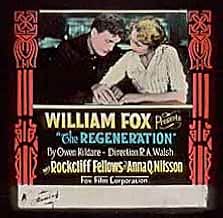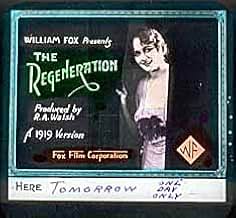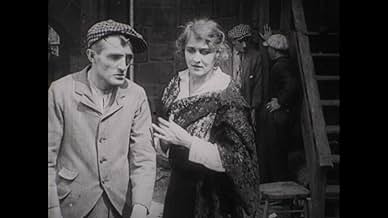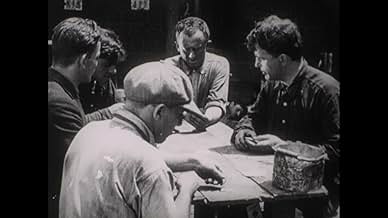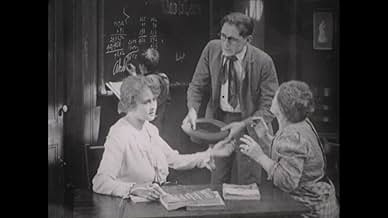CALIFICACIÓN DE IMDb
6.8/10
1.5 k
TU CALIFICACIÓN
Agrega una trama en tu idiomaA boy surrounded by violence grows up to become an infamous gangster.A boy surrounded by violence grows up to become an infamous gangster.A boy surrounded by violence grows up to become an infamous gangster.
- Dirección
- Guionistas
- Elenco
- Premios
- 1 premio ganado en total
James A. Marcus
- Jim Conway
- (as James Marcus)
Harry McCoy
- Owen - Age 17
- (as H. McCoy)
Peggy Barn
- Woman
- (sin créditos)
William Dyer
- Drunk Friend of Jim Conway
- (sin créditos)
Opiniones destacadas
In cinema, 1915 is best known as the year of DW Griffith's epic Birth of a Nation. While I won't play down the talents and achievements of Griffith, his debut feature was merely a culmination of his prior achievements, a milestone in cinema culture but adding nothing to cinematic language. Regeneration however, a largely overlooked film (although it has its champions), was perhaps truly the most important picture of that year.
Raoul Walsh, previously an assistant to Griffith, and already having a handful of short features to his name, made his full-length debut with this romantic gangster fable. The picture opens fairly conventionally for the time, Walsh displaying an incredibly firm grasp of film form for such a young director. The opening shot establishes the mood - the recently bereaved protagonist sitting alone in a bare room, a curtain billowing forlornly behind him, after which we cut away to the hearse bearing his mother in the street outside. However, we then see the lad go to the window and look down. In the very next shot, the camera is looking down at the hearse, exactly as he would see it. Bam! The point-of-view shot is born.
The point-of-view shot is not merely a convenient alternative angle for storytelling. It places the audience into the position of the character. It's something unique to cinema you can't recreate that in the theatre. The only real equivalent is in novels, when the narrative is told from a character's perspective. Walsh here gives cinema that ability, and moves the audience from the position of spectator to that of participant. It's particularly apt too for Regeneration, as it was adapted from an autobiography. Walsh remains consistent to the story's roots by primarily showing the points of view of the protagonist, Owen.
Another great thing about Regeneration is its use of dolly shots that is, moving the camera in or out, towards or away from the action. This wasn't an innovation as such, the dolly having been invented by Giovanni Pastrone for his 1914 epic Cabiria, but the dolly shots in that picture are largely uninspired, at best creating smooth transitions between different length shots. Walsh however really explores the possibilities of the technique. First he uses it to home in on the young Owen in the scene where his adoptive parents argue over the dinner table. Again this is a move which draws us into the character's world, as if we are being pulled forward and forced to look. Much later, in the scene where Anna Q. Nilsson bursts into the gangster's den, the camera itself rushes forward, reaching the centre of the shot at the same pace she does. In effect, the camera movement mimics hers and gives the audience a little taste of her sense of urgency.
Needless to say, there is a lot more to Regeneration than these pioneering camera techniques. Walsh's handling of the dynamic moments is particularly adept, with a climactic ride-to-the-rescue worthy of Griffith, and some particularly realistic fight scenes. But he was just as capable of great tenderness as he was of great action, and the picture is shot through with the sense of melancholy romanticism that is typical of Walsh. And let's not forget the fine naturalistic acting on display, although stars Rockliffe Fellowes and Anna Q. Nilsson would soon fade into obscurity.
By way of a disclaimer, I should point out that Regeneration may not literally be the first motion picture to use point-of-view shots. There was, after all, a wealth of experimentation in the early days of cinema, and many films are obscure or lost. It is shortly after this though that the technique seems to enter mainstream usage. For example, Cecil B. DeMille's The Cheat, made several months after Regeneration, features point-of-view shots, whereas DeMille's Carmen, made about the same time as Regeneration, does not. Tag Gallagher, in his superb essay on Walsh for Senses of Cinema, makes similar claims. Whatever the case, Walsh certainly excelled in a new kind of cinema, one which placed the audience inside the story, and this principle would shape much of Walsh's work throughout his fifty-year career.
Raoul Walsh, previously an assistant to Griffith, and already having a handful of short features to his name, made his full-length debut with this romantic gangster fable. The picture opens fairly conventionally for the time, Walsh displaying an incredibly firm grasp of film form for such a young director. The opening shot establishes the mood - the recently bereaved protagonist sitting alone in a bare room, a curtain billowing forlornly behind him, after which we cut away to the hearse bearing his mother in the street outside. However, we then see the lad go to the window and look down. In the very next shot, the camera is looking down at the hearse, exactly as he would see it. Bam! The point-of-view shot is born.
The point-of-view shot is not merely a convenient alternative angle for storytelling. It places the audience into the position of the character. It's something unique to cinema you can't recreate that in the theatre. The only real equivalent is in novels, when the narrative is told from a character's perspective. Walsh here gives cinema that ability, and moves the audience from the position of spectator to that of participant. It's particularly apt too for Regeneration, as it was adapted from an autobiography. Walsh remains consistent to the story's roots by primarily showing the points of view of the protagonist, Owen.
Another great thing about Regeneration is its use of dolly shots that is, moving the camera in or out, towards or away from the action. This wasn't an innovation as such, the dolly having been invented by Giovanni Pastrone for his 1914 epic Cabiria, but the dolly shots in that picture are largely uninspired, at best creating smooth transitions between different length shots. Walsh however really explores the possibilities of the technique. First he uses it to home in on the young Owen in the scene where his adoptive parents argue over the dinner table. Again this is a move which draws us into the character's world, as if we are being pulled forward and forced to look. Much later, in the scene where Anna Q. Nilsson bursts into the gangster's den, the camera itself rushes forward, reaching the centre of the shot at the same pace she does. In effect, the camera movement mimics hers and gives the audience a little taste of her sense of urgency.
Needless to say, there is a lot more to Regeneration than these pioneering camera techniques. Walsh's handling of the dynamic moments is particularly adept, with a climactic ride-to-the-rescue worthy of Griffith, and some particularly realistic fight scenes. But he was just as capable of great tenderness as he was of great action, and the picture is shot through with the sense of melancholy romanticism that is typical of Walsh. And let's not forget the fine naturalistic acting on display, although stars Rockliffe Fellowes and Anna Q. Nilsson would soon fade into obscurity.
By way of a disclaimer, I should point out that Regeneration may not literally be the first motion picture to use point-of-view shots. There was, after all, a wealth of experimentation in the early days of cinema, and many films are obscure or lost. It is shortly after this though that the technique seems to enter mainstream usage. For example, Cecil B. DeMille's The Cheat, made several months after Regeneration, features point-of-view shots, whereas DeMille's Carmen, made about the same time as Regeneration, does not. Tag Gallagher, in his superb essay on Walsh for Senses of Cinema, makes similar claims. Whatever the case, Walsh certainly excelled in a new kind of cinema, one which placed the audience inside the story, and this principle would shape much of Walsh's work throughout his fifty-year career.
People who think that all silents are sticky with Victorian melodrama will be surprised by the sustained pace, the bracing realism, and the soft-pedaling of the sentimental elements of this startlingly fresh film. The 28-year old Raoul Walsh had already written and produced a dozen films when he directed this. Although the narrative rambles a bit, Walsh's dynamic use of film grammar - closeups, dollies in and out, cross-cutting between scenes, sharp editing - makes REGENERATION look more modern than many silent films made ten years later. Walsh shows his creativity when he uses the circling movements of dancers to foreshadow public panic in an impressively staged sequence of a fire [although it has little plot function]. Titles are used sparingly throughout, and even they are terse and direct. The performances are also surprisingly natural, from square-jawed Rockcliffe Fellowes [who looks something like Robert Stack] to Anna Q. Nilsson, who gives a delicate, sympathetic performance as the good girl/settlement worker. Within the outline of a traditional melodrama, Walsh forthrightly portrays the underside of contemporary society, keeps the sentiment light, and provides an ending that is not without surprises either.
By the standards of its time, this is a better than average film, and it is still watchable, even though the social and cinematic conventions of 1915 may make it rather quaint to some viewers. Still, the theme about a good woman regenerating a rascal is not unusual today, and here it is told with coherence and simplicity.
One may find the acting style quaint, too, but some of the worst excesses of the silent days are avoided for the most part. Perhaps we can thank young Raoul for that. The editing is choppy, but that may be due to losses over the years, and it may vary depending on the print or tape translation one sees.
One may find the acting style quaint, too, but some of the worst excesses of the silent days are avoided for the most part. Perhaps we can thank young Raoul for that. The editing is choppy, but that may be due to losses over the years, and it may vary depending on the print or tape translation one sees.
Rather than repeat what others have written, I'd like to comment on how this film managed to get into circulation.
The only known print of the film was found in the basement of a building in Montana in 1976. Preserved (and not too soon given the deterioration seen in the middle of the film), it was part of a series of films shown during the New York Film Festival representing titles which had recently (1978) been saved. I remember seeing all of them; they included Lillom (recently issued on DVD in the Murnau/Borzage box and worth seeing), and The Letter (with Jeanne Eagles, which blew everyone away).
It is a miracle that films still turn up in such a manner even this late in the game. Most films from this time period have long ago turned into flammable dust (they started to deteriorate as early as the thirties), and it is particularly fortunate that "Regeneration" is now among the living. Despite its crudities, it feels like a documentary of the seedier elements of New York, and it still works its magic; it has matured very well. Given that we can see how the streets of New York really looked almost 100 years ago, the film may play better than it did back then. Most of the people in this film are not actors, they are real people, and that is what we reacted to when we saw this back in the seventies.
Additionally, the film is a real window into the transitional period when the one-reeler had turned into a longer, more ambitious feature. As a first feature for Walsh, this film is really extraordinary when we consider that the tools of film-making were still crude (the comments on the editing of the film are correct. However, the abruptness plays better on the big screen). Even more, the film also reminds us that the numerous features made between 1914 and 1920 included some real gems that are gone forever, and cannot be re-evaluated. How many really good actors and directors are known in name only because their work has disappeared?
I consider this one of the finest examples of an early silent feature, and one of the landmark films of the silent era. It is an illustration of how the director of that time found his or her way, made mistakes and had chances to improve. It shows how filmmakers were taking the vocabulary used by Griffith and some European filmmakers to expand the techniques of storytelling to hold an audience's interest for an hour's worth of entertainment.
A must-see if you are interested in silent films.
The only known print of the film was found in the basement of a building in Montana in 1976. Preserved (and not too soon given the deterioration seen in the middle of the film), it was part of a series of films shown during the New York Film Festival representing titles which had recently (1978) been saved. I remember seeing all of them; they included Lillom (recently issued on DVD in the Murnau/Borzage box and worth seeing), and The Letter (with Jeanne Eagles, which blew everyone away).
It is a miracle that films still turn up in such a manner even this late in the game. Most films from this time period have long ago turned into flammable dust (they started to deteriorate as early as the thirties), and it is particularly fortunate that "Regeneration" is now among the living. Despite its crudities, it feels like a documentary of the seedier elements of New York, and it still works its magic; it has matured very well. Given that we can see how the streets of New York really looked almost 100 years ago, the film may play better than it did back then. Most of the people in this film are not actors, they are real people, and that is what we reacted to when we saw this back in the seventies.
Additionally, the film is a real window into the transitional period when the one-reeler had turned into a longer, more ambitious feature. As a first feature for Walsh, this film is really extraordinary when we consider that the tools of film-making were still crude (the comments on the editing of the film are correct. However, the abruptness plays better on the big screen). Even more, the film also reminds us that the numerous features made between 1914 and 1920 included some real gems that are gone forever, and cannot be re-evaluated. How many really good actors and directors are known in name only because their work has disappeared?
I consider this one of the finest examples of an early silent feature, and one of the landmark films of the silent era. It is an illustration of how the director of that time found his or her way, made mistakes and had chances to improve. It shows how filmmakers were taking the vocabulary used by Griffith and some European filmmakers to expand the techniques of storytelling to hold an audience's interest for an hour's worth of entertainment.
A must-see if you are interested in silent films.
I became obsessed with this movie two years ago after checking it out of our great NYC library. I rave about it to my friends. To think that this full-length feature was made in l915 is astounding. Maybe it's because of its amazing star, Rockliffe Fellowes, who looks so much like Marlon Brando you'll be double-takes. That he never became a legendary star is a real tragedy but when you think of it, almost none of the film actors from that era survived into the 20s except for Mary Pickford and a few comedians. Rockcliffe is so natural, as is his co-star, the beautiful Anna Q. Nillsen, you have to remind yourself that they were acting. This movie should be studied in film courses to show today's younger movie buffs what dynamic work was being done back int he "dinosaur" age of films. And maybe, like myself, they'll never forget the fantastic Rockliffe Fellowes. This guy "coulda been a contendah!"
¿Sabías que…?
- TriviaMost of the extras in this film were real locals from the Bowery area, as well as from Hell's Kitchen, and had never appeared before in films. Most of the gangster characters were actual gangsters in real life.
- Citas
District Attorney Ames: Very fine and loyal, my boy, but you can't save your friend, and you have lost whatever chance you had - with her.
- Créditos curiososThere is no cast list during the opening credits or at the end. Actors, however, are credited by intertitles as they appear within the movie, and that is used for the IMDb cast ordering. Actors never mentioned are marked uncredited.
- Versiones alternativasKino International released a version which runs 72 minutes and contains an uncredited piano score.
Selecciones populares
Inicia sesión para calificar y agrega a la lista de videos para obtener recomendaciones personalizadas
Detalles
- Fecha de lanzamiento
- País de origen
- Idioma
- También se conoce como
- Возрождение
- Locaciones de filmación
- Hudson River, Nyack, Nueva York, Estados Unidos(burning of the excursion barge)
- Productora
- Ver más créditos de la compañía en IMDbPro
- Tiempo de ejecución
- 1h 12min(72 min)
- Color
- Mezcla de sonido
- Relación de aspecto
- 1.33 : 1
Contribuir a esta página
Sugiere una edición o agrega el contenido que falta

